Public health graduate students can now split their time between online and on-campus classes.
The Milken Institute School of Public Health will allow all of its graduate students to take part of their course loads online or on-campus starting next semester. The flexible program option will give students the opportunity to customize their class schedules to include a mix of online and on-campus courses for the first time.
Paul Schiff Berman, the vice provost for online learning and academic innovation, said he expects the program to attract more students to study in the public health school.
“I think over time it will make that degree program and any others that choose that model far more attractive to students, and I suspect we will see an increase in enrollment because of the flexibility that the program is offering,” he said.
Berman, who’s stepping down from his post next month to return as a full-time faculty member at the GW Law School, said the model, which allows students to take classes both online and on-campus in the same semester, could be expanded into other degree programs.
“It will allow professors to design programs to take advantage of the distinctive strengths of both on-campus education and online education,” he said. “So I think from both a student recruitment point of view and a pedagogical point of view, this is a great development, and I hope that more programs will move in that direction in the future.”
Julie DeLoia, the associate dean of academic affairs at the school, said in an email that the program will offer more flexible options to graduate students who are juggling responsibilities outside school. It can attract more non-traditional students who might have outside obligations like a family or a job to balance with their course loads, she said.
“By offering residential students, who may need flexibility because of a job change or family situation, the ability to easily take some classes online, we hope to alleviate some pressure points,” she said. “Conversely, some online students are in the region either permanently or temporarily and would like the opportunity to take a class on campus.”
Students will be able to take a mix of both on-campus and online courses. Students who currently take classes online can now enroll in up to 15 credits on campus, and on-campus students will be allowed to take up to 15 credits online toward their degrees. In the past, on-campus students had to fill out petitions to take courses online, according to a document circulated by the school.
“We hope that by making this type of blended learning more available, our students will have more flexibility regarding their academic planning,” DeLoia said.
The online courses in the school include weekly live sessions, similar to an on-campus lecture, and other assignments that students can complete at any point throughout the course, according to the document.
The University has focused on expanding its online course offerings in recent years, including starting five massive open online courses.
Last year, the University created the eDesign Shop, an in-house office that creates some of GW’s online courses, as a way to cut down on the costs associated with bringing courses online.







